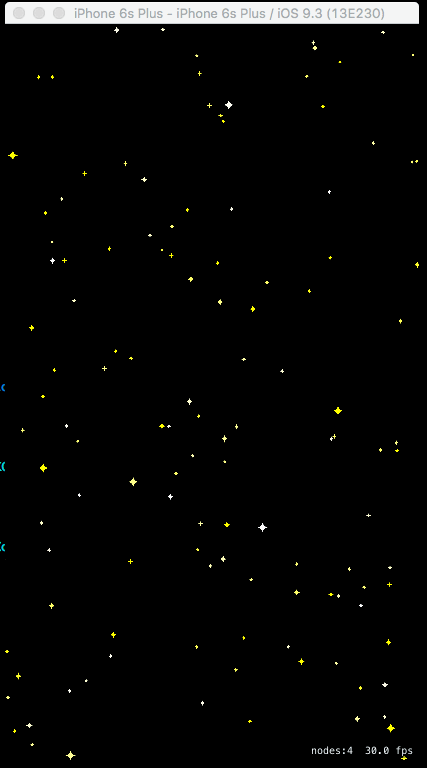I'm building my first game using Swift and SpriteKit and want to add a background. The game takes place in space so I wanted to have stars in the background moving at varying speeds. Currently, I'm going for a 3D look by making the larger stars move across screen faster than the smaller ones. Is there an efficient way to do this rather than making a SKNode subclass like this and adding it as a child at the start of DidMoveToView? It seems like this method is pretty intensive but I thought I'd try it before recycling the same image over and over.
class BackGroundAnimation:SKNode{
let theView:SKView
init(aView:SKView){
theView = aView
super.init()
animate()
}
func animate(){
for _ in 1...200{
let randomSize = random(1, max: 3)
var randomPosx = random(1,max: 1000)
randomPosx = randomPosx/1000.0
var randomPosy = random(1,max: 1000)
randomPosy = randomPosy/1000.0
let star:SKSpriteNode = SKSpriteNode(texture:starTexture)
star.setScale(randomSize/60.0)
star.position = CGPoint(x:(theView.scene?.size.width)! * randomPosx,y:(theView.scene?.size.width)! * randomPosy)// (self.scene.size.width)*randomPosx, y:(self.scene.size.height) * randomPosy)
//star.position = CGPoint(x: 200,y: 200)
star.physicsBody = SKPhysicsBody(circleOfRadius: star.size.width/2 )
star.physicsBody?.collisionBitMask = 0
star.physicsBody?.categoryBitMask = 0
star.physicsBody?.contactTestBitMask = 0
star.physicsBody?.linearDamping = 0
star.physicsBody?.velocity = CGVector(dx:1 * randomSize, dy:0)
star.name = "star"
//addChild(star)
self.addChild(star)
self.moveToParent(self.scene!)
}
}
required init?(coder aDecoder: NSCoder) {
fatalError("init(coder:) has not been implemented")
}
}
Any help would be great.
As I mentioned in a comment, you can create a beautiful parallax background using particles.
Add this function anywhere in your class.
//Creates a new star field
func starfieldEmitterNode(speed speed: CGFloat, lifetime: CGFloat, scale: CGFloat, birthRate: CGFloat, color: SKColor) -> SKEmitterNode {
let star = SKLabelNode(fontNamed: "Helvetica")
star.fontSize = 80.0
star.text = "✦"
let textureView = SKView()
let texture = textureView.textureFromNode(star)
texture!.filteringMode = .Nearest
let emitterNode = SKEmitterNode()
emitterNode.particleTexture = texture
emitterNode.particleBirthRate = birthRate
emitterNode.particleColor = color
emitterNode.particleLifetime = lifetime
emitterNode.particleSpeed = speed
emitterNode.particleScale = scale
emitterNode.particleColorBlendFactor = 1
emitterNode.position = CGPoint(x: CGRectGetMidX(frame), y: CGRectGetMaxY(frame))
emitterNode.particlePositionRange = CGVector(dx: CGRectGetMaxX(frame), dy: 0)
emitterNode.particleSpeedRange = 16.0
//Rotates the stars
emitterNode.particleAction = SKAction.repeatActionForever(SKAction.sequence([
SKAction.rotateByAngle(CGFloat(-M_PI_4), duration: 1),
SKAction.rotateByAngle(CGFloat(M_PI_4), duration: 1)]))
//Causes the stars to twinkle
let twinkles = 20
let colorSequence = SKKeyframeSequence(capacity: twinkles*2)
let twinkleTime = 1.0 / CGFloat(twinkles)
for i in 0..<twinkles {
colorSequence.addKeyframeValue(SKColor.whiteColor(),time: CGFloat(i) * 2 * twinkleTime / 2)
colorSequence.addKeyframeValue(SKColor.yellowColor(), time: (CGFloat(i) * 2 + 1) * twinkleTime / 2)
}
emitterNode.particleColorSequence = colorSequence
emitterNode.advanceSimulationTime(NSTimeInterval(lifetime))
return emitterNode
}
And then add this function too. This is the function that will create the layers of stars. Just call this function, such as in the didMoveToView.
func createStarLayers() {
//A layer of a star field
let starfieldNode = SKNode()
starfieldNode.name = "starfieldNode"
starfieldNode.addChild(starfieldEmitterNode(speed: -48, lifetime: size.height / 23, scale: 0.2, birthRate: 1, color: SKColor.lightGrayColor()))
addChild(starfieldNode)
//A second layer of stars
var emitterNode = starfieldEmitterNode(speed: -32, lifetime: size.height / 10, scale: 0.14, birthRate: 2, color: SKColor.grayColor())
emitterNode.zPosition = -10
starfieldNode.addChild(emitterNode)
//A third layer
emitterNode = starfieldEmitterNode(speed: -20, lifetime: size.height / 5, scale: 0.1, birthRate: 5, color: SKColor.darkGrayColor())
starfieldNode.addChild(emitterNode)
}
And this is how it looks like.

Updated @JozemiteApps solution for Swift 4 / iOS 11
Add this function anywhere in your class.
//Creates a new star field
func starfieldEmitterNode(speed speed: CGFloat, lifetime: CGFloat, scale: CGFloat, birthRate: CGFloat, color: SKColor) -> SKEmitterNode {
let star = SKLabelNode(fontNamed: "Helvetica")
star.fontSize = 80.0
star.text = "✦"
let textureView = SKView()
let texture = textureView.texture(from: star)
texture!.filteringMode = .nearest
let emitterNode = SKEmitterNode()
emitterNode.particleTexture = texture
emitterNode.particleBirthRate = birthRate
emitterNode.particleColor = color
emitterNode.particleLifetime = lifetime
emitterNode.particleSpeed = speed
emitterNode.particleScale = scale
emitterNode.particleColorBlendFactor = 1
emitterNode.position = CGPoint(x: frame.midX, y: frame.maxY)
emitterNode.particlePositionRange = CGVector(dx: frame.maxX, dy: 0)
emitterNode.particleSpeedRange = 16.0
//Rotates the stars
emitterNode.particleAction = SKAction.repeatForever(SKAction.sequence([
SKAction.rotate(byAngle: CGFloat(-Double.pi/4), duration: 1),
SKAction.rotate(byAngle: CGFloat(Double.pi/4), duration: 1)]))
//Causes the stars to twinkle
let twinkles = 20
let colorSequence = SKKeyframeSequence(capacity: twinkles*2)
let twinkleTime = 1.0 / CGFloat(twinkles)
for i in 0..<twinkles {
colorSequence.addKeyframeValue(SKColor.white,time: CGFloat(i) * 2 * twinkleTime / 2)
colorSequence.addKeyframeValue(SKColor.yellow, time: (CGFloat(i) * 2 + 1) * twinkleTime / 2)
}
emitterNode.particleColorSequence = colorSequence
emitterNode.advanceSimulationTime(TimeInterval(lifetime))
return emitterNode
}
And then add this function too. This is the function that will create the layers of stars. Just call this function, such as in the didMoveToView.
func createStarLayers() {
//A layer of a star field
let starfieldNode = SKNode()
starfieldNode.name = "starfieldNode"
starfieldNode.addChild(starfieldEmitterNode(speed: -48, lifetime: size.height / 23, scale: 0.2, birthRate: 1, color: SKColor.lightGray))
addChild(starfieldNode)
//A second layer of stars
var emitterNode = starfieldEmitterNode(speed: -32, lifetime: size.height / 10, scale: 0.14, birthRate: 2, color: SKColor.gray)
emitterNode.zPosition = -10
starfieldNode.addChild(emitterNode)
//A third layer
emitterNode = starfieldEmitterNode(speed: -20, lifetime: size.height / 5, scale: 0.1, birthRate: 5, color: SKColor.darkGray)
starfieldNode.addChild(emitterNode)
}
If you love us? You can donate to us via Paypal or buy me a coffee so we can maintain and grow! Thank you!
Donate Us With